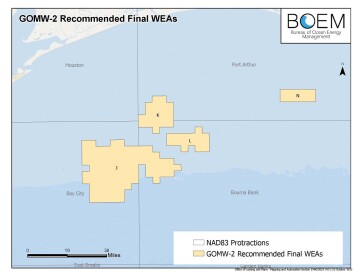The Biden/Harris administration announced its approval of the Coastal Virginia Offshore Wind (CVOW) commercial project—the administration’s fifth approval of a commercial-scale, offshore wind energy project. The announcement follows the approval of the Vineyard Wind 1, South Fork Wind, Ocean Wind 1, and Revolution Wind projects. When completed, these five projects are expected collectively to add more than 5 GW of energy to the nation’s grid, enough to power more than 1.75 million homes.
Approximately 23.5 nautical miles offshore Virginia Beach, the CVOW commercial project is the largest yet and would provide about 2,600 MW of energy, capable of powering more than 900,000 homes. The project is expected to provide about 900 jobs each year during the construction phase and support an estimated 1,100 annual jobs during the operations phase.
“The Interior Department is committed to the Biden/Harris administration’s all-of-government approach to the clean energy future, which helps respond to the climate crisis, lower energy costs, and create good-paying union jobs across the manufacturing, shipbuilding and construction sectors,” said Secretary of the Interior Deb Haaland. “Today’s approval of the largest offshore wind project in US history builds on the undeniable momentum we are seeing. Together with the labor community, industry, tribes, and partners from coast to coast, we are aggressively working toward our clean energy goals.”
The announcement comes on the heels of an October 27 event in Portsmouth, Va., to celebrate the arrival of the first eight monopile foundations for the CVOW project.
“The Biden-Harris administration just greenlit construction of the nation’s fifth massive-scale offshore wind project, growing a new American industry, lowering energy costs, creating good-paying jobs, and tackling the climate crisis,” said White House National Climate Advisor Ali Zaidi. “More progress and economic opportunity are on the horizon as we put to use every tool available to bring offshore wind benefits to American workers and communities nationwide.”
Gulf Wind
Earlier, the Bureau of Ocean Energy Management (BOEM) announced it has finalized four new wind energy areas (WEAs) in the Gulf of Mexico (Fig. 1). Together, the WEAs could support offshore wind projects with the potential to produce enough energy to power more than 3 million homes. This announcement follows the first Gulf of Mexico offshore wind lease sale earlier this year.

“Creating an offshore wind industry in the Gulf of Mexico will take time and partnership. BOEM is pursuing another offshore wind lease sale in the Gulf of Mexico due to continued industry interest and feedback from our partners and key stakeholders,” said BOEM Director Elizabeth Klein. “BOEM will continue to work with the tribes, other government partners, coastal states, ocean users, and local communities as we advance our work in a manner that seeks to responsibly develop offshore areas while minimizing potential conflicts with other ocean uses and marine life in the Gulf of Mexico.”
Before finalizing the WEAs, BOEM collaborated with NOAA’s National Centers for Coastal Ocean Science to build a model that analyzed the entire Gulf of Mexico ecosystem to identify and minimize potential conflicts with marine resources and ocean users. BOEM also incorporated feedback from tribes, other government agencies, ocean users, and others to help identify potential offshore locations that appeared most suitable for offshore wind energy development.
The four WEAs are:
- Option J—495,567 acres approximately 47.2 miles off the coast of Texas, with the potential to support projects that could power 2.1 million homes
- Option K—119,635 acres approximately 61.5 miles off the coast of Texas, with the potential to support projects that could power 508,200 homes
- Option L—91,157 acres approximately 52.9 miles off the coast of Texas, with the potential to support projects that could power 387,450 homes
- Option N—56,978 acres approximately 82 miles off the coast of Louisiana with the potential to support projects that could power approximately 242,000 homes

